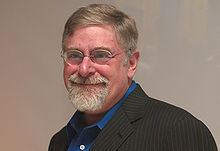Name David Ungar Role Computer scientist | Academic advisor David Patterson Notable students Urs Holzle | |
 | ||
Books The design and evaluation of a high performance Smalltalk system Similar Urs Holzle, David Patterson, John L Hennessy, Ginni Rometty | ||
Cmsv tocs david ungar 2011 11 22
David Michael Ungar, an American computer scientist, co-created the Self programming language with Randall Smith. The SELF development environment's animated user experience was described in the influential paper Animation: From Cartoons to the User Interface co-written with Bay-Wei Chang, which won a lasting impact award at the ACM Symposium on User Interface Software and Technology 2004.
Contents
Ungar graduated as a doctor of philosophy in computer science from the University of California, Berkeley, in 1985. His doctoral advisor was David Patterson and his dissertation was entitled The Design and Evaluation of a High-Performance Smalltalk System; it won the 1986 ACM Doctoral Dissertation Award.
He was an assistant professor at Stanford University, Dept. of Electrical Engineering, Computer Systems Lab, where he taught programming languages and computer architecture, from 1985 to 1990. In 1991, he joined Sun Microsystems and became a distinguished engineer. In 2006 he was recognized as a Distinguished Engineer by the Association for Computing Machinery and in 2010 a Fellow. In 2007, he joined IBM Research, where he is currently a member of the Dynamic Optimization Group. Ungar holds 20 US patents.
In 2006 the 1987 Self paper, coauthored by Ungar and Randall B. Smith, was selected as one of the three most influential OOPSLA papers presented between 1986 and 1996. Self was also one influence on the design of the JavaScript programming language. Ungar's 1984 paper, Generation Scavenging: A Non-disruptive High Performance Storage Reclamation Algorithm, which introduced generational garbage collection, won a Retrospective ACM SIGSOFT Impact Paper Award in 2008.
Dave Ungar was awarded the Dahl-Nygaard Senior Prize in 2009.
